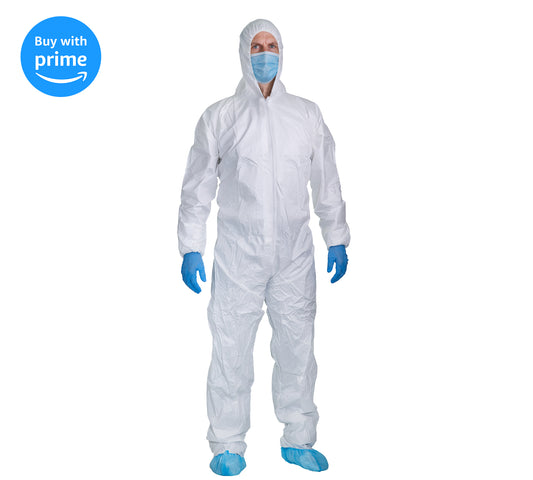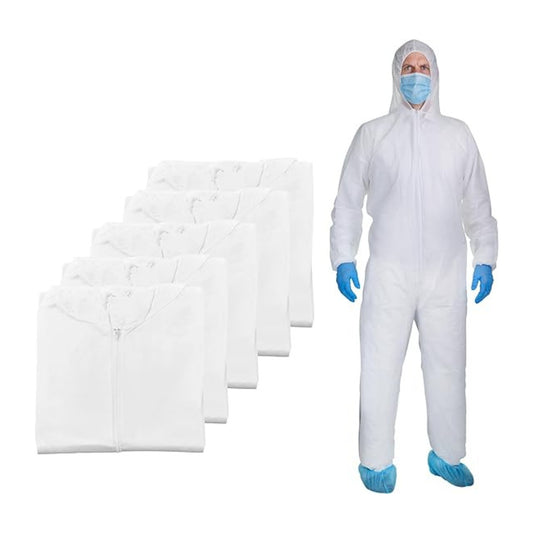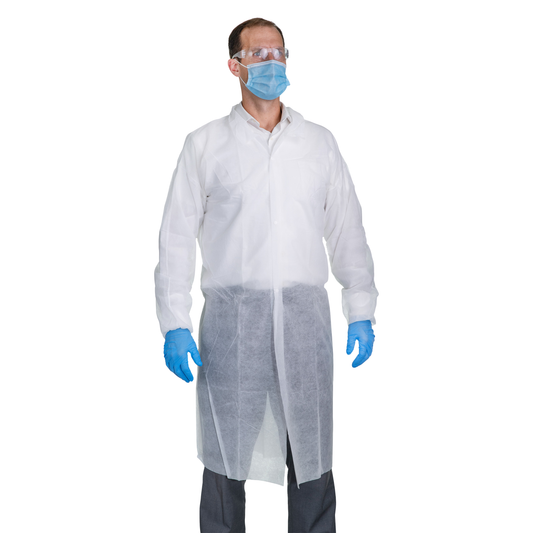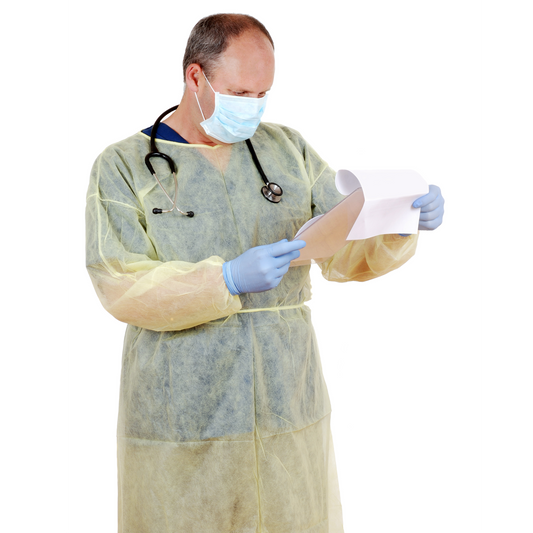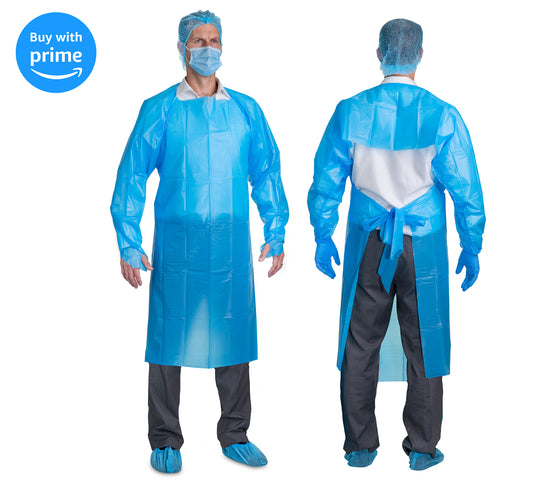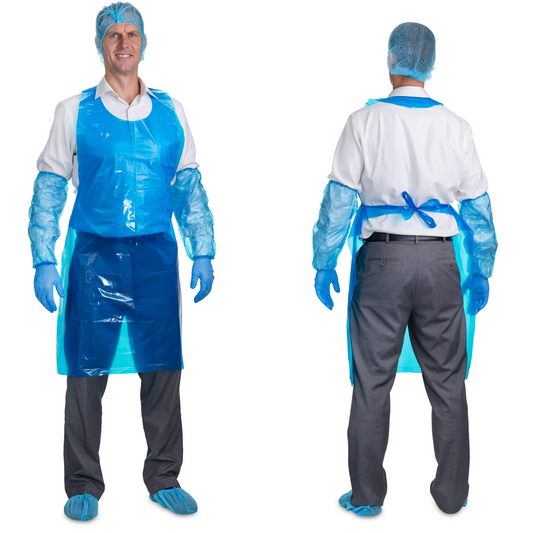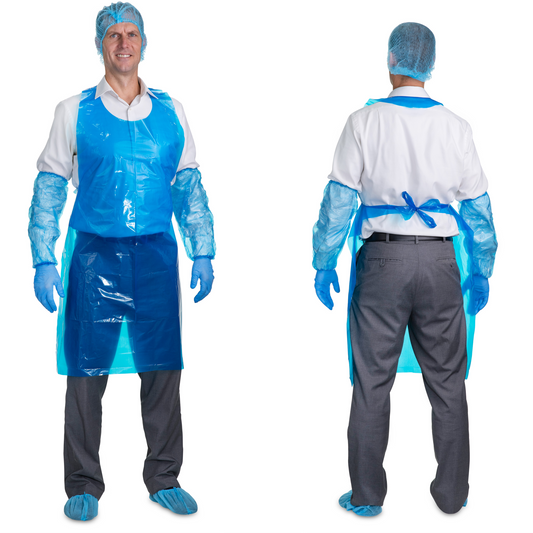Collection: Wholesale Body Protection
Disposable Coveralls, lab coats, gowns, aprons, even pants -we can do it! When it comes to barrier protection for your body, there are numerous options. Think of body protection like clothing. In clothing, there are three primary aspects:
- Material of clothing
- Type of garment
- Style of garment
For instance, with with a pullover, it can be made of cotton, wool, polyester, nylon, another material or a combination of materials. For simplicity, let’s say the pullover you choose is a cotton pullover. The style of the pullover means that the pullover has two side pockets, no collar, and a zipper that zips halfway up. The style of a garment represents the majority of complexity of design and manufacturing because there are myriad variations and styles each garment can have (an essence of fashion). While most people don’t consider disposable body protection fashionable -it can be complex…but it doesn’t have to be.
When it comes to the type of garments within body protection there are 4 primary types of garments:
- Gowns
- Lab coats
- Coveralls
- Aprons
- Pants
In terms of usage, gowns and lab coats represent the largest market share of the body protection market because each of those items is heavily used within the medical market. Coveralls are also used by a significant number of industries, but primarily in the industrial market. Whereas, aprons are mostly used within the food industry and lastly, pants are used in niche situations.
Disposable Gowns generally provide body coverage on the torso, arms. Some gowns provide back coverage -whereas others do not provide coverage on the back. Very few gowns provide barrier protection from the waist down or on the head. Most gowns are made of PP and SMS, although there are gowns made of PE material too.
Disposable Labcoats all provide barrier protection on the front and back of the torso, unlike some gowns. Also, unlike most gowns, there are a wide variety of styles of lab coats (buttons, zippers, pockets, collars, elastic wrists, etc.). Most lab coats are made of PP or SMS material.
Disposable Coveralls provide the most body protection of any garment. While there are many styles of coveralls, most lab coats cover your legs, torso, and head. Some coveralls cover your feet as well. Most common variations are related to hoods, booties, zippers, buttons, and tape on the seams. As for material, most coveralls are made of PP, but you can find many coveralls made of microporous and SMS.
Disposable Aprons primarily cover the front of your body or your chest. Depending on the size and length of material, some coveralls cover a portion of your back or a portion of your arms, but most only cover your upper torso. These are made of PE, PP and PVC material.
Disposable Pants are rarely used in the market, but when they are used it is made of PP, SMS or Microprous material in the medical or corrections environment. Pants are used as a scrubs replacement or coverall, gown, or lab coat is not sufficient for the specific task at hand. While this garment has the least demand, we are certainly open to discussing your pant need.
As for materials, there are 4 primary types of materials used in disposable body protection. Bear in mind, all disposable body protection is considered non-woven material. Meaning, it is not a woven textile product -it is a plastic based product. As such, all of the materials used to make disposable body protection are plastic products.
- PE
- PP
- SMS
- Microporous
- PVC
PE stands for Polyethelyene material. Trashbags are made from this material. Polyethelyene is the most commonly manufactured plastic in the world. All of these plastics are water resistant, generally durable and provide good barrier protection depending on how they are used (e.g. certain materials perform better under certain conditions). PE material is generally considered the least expensive material within body protection.
PP stands for Polypropylene. PP is basically like a plastic paper. While still water resistant, it is more breathable than PE material. While more expensive than PE, it is significantly less expensive than SMS and Microporous material.
SMS is a type of PP material. It stands for Spunbond, Melt blown, Spunbond. What distinguishes SMS material is how the PP material is processed. When SMS is manufactured, PP is processed with a machine that separates the plastic compounds apart and turns the PP material into what looks and feels like cotton candy. This process is called “Spunboning”. This process increases the material’s surface area and changes the material dynamics of the PP material. Afterward, the material is “meltblown” meting the material decreases the permeability of the PP material. After it has been melt blown, it is again Spunbond to add material elasticity and improve the feel of the product. SMS is far more expensive than PP, but it is far less permeable garment. SMS is most appropriate for Operating Rooms, medical settings, or clean room environments where it is important to prevent any permeability of liquid to or from the garment. Hypothetically, a garment can be SMMS or SMMMS if a person is looking to minimize liquid permeability.
Microporous material is a flash spun PE material. This material is used in building insulation, for packages, and for personal protective equipment (PPE). Most are familiar with the company Dupont. Several decades ago, Dupont promoted its brand Tyvek selling patented versions of microporous material. While Tyvek is a great variation of this product, the underlying material is a microporous PE simply known as microporous. This is the least permeable material in body protection. The permeability is less than 2 nano meters. Unfortunately, it is the most expensive material and the least breathable material; however, for high risk situations, most Hazmat suites utilize are a variation of microporous material. Within microporous material there are a wide variety of specifications; however, most garments made using this material are coveralls.
PVC stands for polyvinylchloride. Mostly disposable sleeves and gloves are made of our this material. Only some aprons utilize material. PVC has the best “hand” or overall feel of all the plastic materials in non-woven. However, it is the most dense, most expensive second to microporous material. While many people prefer to feel and comfort of the material, the cost is prohibitive for most as it relates to body protection.
When it comes to body protection, we recognize no two people are the same as such no PPE provider should provide a one fit solution for all companies. We work you find the best product for the task at hand.
-
Microporous Protective Tyvek Coverall Suits With Hood Elastic Wrists, Ankles and Waist, Single Zipper, For Painting/Industrial Use
Regular price From $31.49Regular priceUnit price / per -
White Disposable Coveralls with Hood, Polypropylene PP Breathable Material, used for Spray Painting and Cleaning Work
Regular price From $4.49Regular priceUnit price / per -
Lab Coats Disposable for Adults, White, Breathable, 3 Buttons, No Pockets
Regular price From $9.99Regular priceUnit price / per -
Disposable Isolation Gown | Yellow | One Size Fits All | Protective Gowns
Regular price From $10.99Regular priceUnit price / per -
Disposable Isolation Gowns, Medical, Food Processing, Dental
Regular price From $16.49Regular priceUnit price / per -
Disposable Heavy Weight Plastic/Polyethylene Aprons Blue and White - Case of 500
Regular price $96.00Regular priceUnit price / per -
Disposable Heavy Weight Polyethylene Aprons, White and Blue, Case of 1000 or Pack of 100
Regular price From $16.49Regular priceUnit price / per

